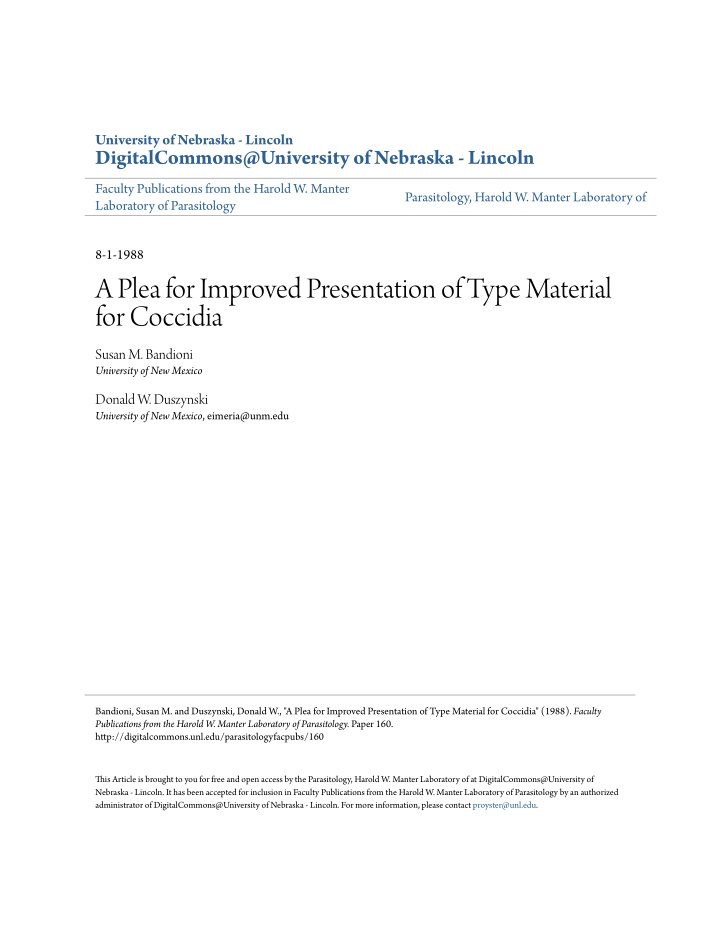



University of Nebraska - Lincoln DigitalCommons@University of Nebraska - Lincoln Faculty Publications from the Harold W. Manter Parasitology, Harold W. Manter Laboratory of Laboratory of Parasitology 8-1-1988 A Plea for Improved Presentation of Type Material for Coccidia Susan M. Bandioni University of New Mexico Donald W. Duszynski University of New Mexico , eimeria@unm.edu Bandioni, Susan M. and Duszynski, Donald W., "A Plea for Improved Presentation of Type Material for Coccidia" (1988). Faculty Publications fsom the Harold W. Manter Laboratory of Parasitology. Paper 160. htup://digitalcommons.unl.edu/parasitologyfacpubs/160 Tiis Article is brought to you for free and open access by the Parasitology, Harold W. Manter Laboratory of at DigitalCommons@University of Nebraska - Lincoln. It has been accepted for inclusion in Faculty Publications from the Harold W. Manter Laboratory of Parasitology by an authorized administrator of DigitalCommons@University of Nebraska - Lincoln. For more information, please contact proyster@unl.edu.
J. Parasit., pp. 519-523 74(4), 1988, ? American of Parasitologists Society 1988 INVITED CRITICAL COMMENT... PRESENTATION OF TYPE MATERIAL A PLEA FOR IMPROVED FOR COCCIDIA Susan M. Bandoni and Donald W. Duszynski Department of Biology, The University of New Mexico, Albuquerque, New Mexico 87131 ABSTRACT: The "true" coccidia suborder constitute a large and (phylum Apicomplexa, Eimeriina) heterogeneous of parasitic protozoa. Despite the large number of described species (ca. 1,650) and the medical and group of some (e.g., Toxoplasma), 2 facts are clear: (1) the majority of coccidia species are veterinary importance and (2) the phylogenetic of those described species are poorly known. probably yet undescribed, relationships to the latter dilemma is the lack of a tradition to provide by those who describe Contributing type specimens new species, even though the International Code of Zoological Nomenclature recommends the specifically designation of a type specimen with the description of a new species. With the publication of a new edition of the Code (1985), explicit provisions are made for the unique concerns of taxonomists working with Protozoa. Here we remind those interested in the taxonomy of coccidia of an already established method for preserving oocysts in resin and, as an alternative, the standardization of a photographic which suggest procedure through of coccidian also be submitted to and maintained in accredited museums. type specimens oocysts might Thus, coccidia taxonomists should no longer have an excuse for their failure to designate types. The protozoan phylum Apicomplexa Levine, to developing methods to preserve coccidian 1970, comprises a large and heterogeneous group oocysts permanently or to other viable alterna- of obligate intracellular parasites including many tives. Consequently, reference collections of pre- species of medical and veterinary significance served specimens of eimeriid species do not ex- (e.g., Plasmodium, Babesia, Cryptosporidium, ist, with but few exceptions (e.g., Calyptospora Eimeria, and Toxoplasma). About one-third of empristica, see Fournie et al., 1985). the approximately 4,600 described species in the According to the most recent edition of the phylum are placed in a single family, Eimeriidae, Zoological Code (Ride et al., 1985), a type spec- and the vast majority of these species are known imen serves as "the objective standard of refer- from a single life-cycle stage, the sporulated ence by which the application of the name it oocyst. It is the process by which new eimeriids bears is determined, no matter how the bound- are described that we wish to address in this aries of the taxon may change" (Article 61 (a), essay. p. 115). Thus, the type specimen is intended to be unchanging and objective, whereas the limits HISTORICAL PERSPECTIVE of a nominal species are recognized to be sub- Although the names of apicomplexans reflect jective and transient. The type specimen, there- the use of the International Code of Zoological fore, serves as an anchor for the name, and to Nomenclature, the taxonomic procedure fol- some extent, it is the name (see Mayr et al., 1953). lowed in documenting the existence of new ei- The Bacteriological Code of Nomenclature meriid species has not been consistent with the (Lapage et al., 1975) allows, and indeed encour- intention of the Code. For example, the Code ages, the submission of cultures to a type culture explicitly recommends the designation of type collection. Apicomplexans cannot be cultured specimens for new species, but a type tradition axenically, and although some eimeriid species is lacking among taxonomists working with the have been cultured in host cells, the technical Eimeriidae. difficulties in culturing new species isolated from Historically, under the Zoological Code, "the wild animals preclude the routine submission of type is a specimen," with the implication that type cultures. the type specimen will be available for future Both the Botanical Code (Voss et al., 1983; study. Unfortunately, most scientists describing Article 9.3) and the Bacteriological Code (Rule new coccidian species have not devoted attention 18A) have made provisions for organisms that cannot be permanently preserved: drawings are acceptable as type specimens. Previous editions Received 2 October 1987; revised 18 March 1988; 22 March 1988. of the Zoological Code have allowed illustrations accepted 519
Recommend
More recommend